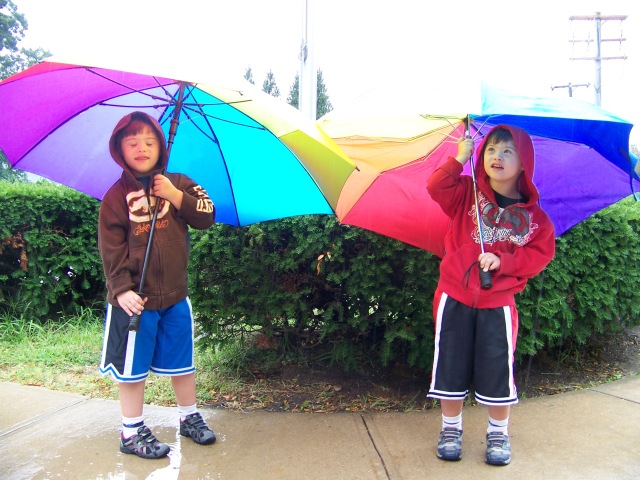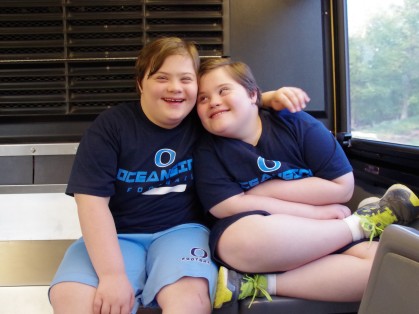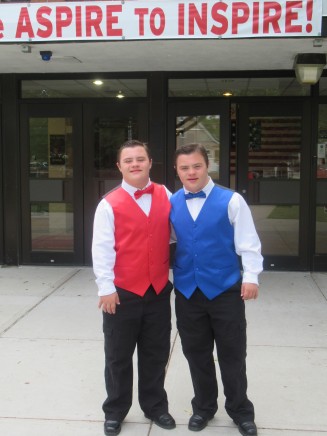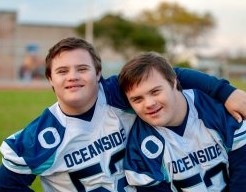
REGRET. To feel disappointed over something that has happened — or has not happened — especially in the sense of a missed opportunity. Say like when I was younger and single and couldn’t get up the nerve to talk to that cute guy when I had the chance. Ahhh, what might have been? Or not… (In truth, I have no regrets in that area LOL).
Self-help books tout acceptance as the most effective way to resolve regret. Something learned and, hopefully, applied the next time around. I’ve learned to accept and let go of most regrets pretty easily. Especially because the next time that sort of opportunity presented itself, I seized the day and ended up with a date that was worse than unremarkable. (My oodles of bad dates before “Lou” are tales for another day or another blog LOL.) But, what of the regrets over a lost opportunity that has NO chance of ever presenting itself again?
In most cases, when this happens, I tell myself it simply was not meant to be. But that’s not so easy when the lost opportunity affects someone I love — especially My Children and, specifically, their well-being and their stature… literally!
I can’t change what happened – or didn’t happen – for us. That’s acceptance, I guess (though I still feel regret as I type that). But, sharing our experience so that someone else can learn and maybe benefit from our missed opportunity may relieve some of the regret I feel.
My Identical Twin Sons were born with an extra copy of the 21st chromosome, a genetic condition known as Down syndrome (DS). They were lean and strong throughout their first ten years of life. They are still wicked strong. But, somewhere  around 5th grade, I began to worry about their suddenly chubby faces, development of breasts, and increasing weight. I was concerned because, I thought, I’ve struggled with my weight all my life. What if they were not able to manage a lifelong struggle with weight loss let alone weight maintenance (since I’d mostly failed at doing so myself)? After perusing the internet with no standout solutions beyond the sentiment that we should not put our children on “diets” but rather make changes to their eating habits (am I the only one who doesn’t quite understand the difference there?), I went to my pediatrician for advice and he said, “garbage in, garbage out!” I explained that our diet was, in fact, not “garbage” at all but relatively healthy, he offered no additional recommendations. Then, after watching a Dr. Phil episode on childhood obesity, I emailed Dr. Goglia, a Los Angeles, CA fitness guru and Dr. Phil’s weight loss specialist. (Shockingly, he telephoned me directly and said he would help… unfortunately, shortly thereafter he left the country for a long vacation and we never reconnected.) Finally, I asked friends and acquaintances in the Down syndrome community who had older children with DS but no words of wisdom or success stories were forthcoming. Most often, I was told that people with Down syndrome tend to be short and squat, with characteristically larger bellies and bottoms. “Part of the syndrome,” I was told.
around 5th grade, I began to worry about their suddenly chubby faces, development of breasts, and increasing weight. I was concerned because, I thought, I’ve struggled with my weight all my life. What if they were not able to manage a lifelong struggle with weight loss let alone weight maintenance (since I’d mostly failed at doing so myself)? After perusing the internet with no standout solutions beyond the sentiment that we should not put our children on “diets” but rather make changes to their eating habits (am I the only one who doesn’t quite understand the difference there?), I went to my pediatrician for advice and he said, “garbage in, garbage out!” I explained that our diet was, in fact, not “garbage” at all but relatively healthy, he offered no additional recommendations. Then, after watching a Dr. Phil episode on childhood obesity, I emailed Dr. Goglia, a Los Angeles, CA fitness guru and Dr. Phil’s weight loss specialist. (Shockingly, he telephoned me directly and said he would help… unfortunately, shortly thereafter he left the country for a long vacation and we never reconnected.) Finally, I asked friends and acquaintances in the Down syndrome community who had older children with DS but no words of wisdom or success stories were forthcoming. Most often, I was told that people with Down syndrome tend to be short and squat, with characteristically larger bellies and bottoms. “Part of the syndrome,” I was told.
One day, I was having lunch with a lovely young couple and their brand-new little girl who also happens to sport an extra 21st chromosome. We’d planned to meet at a conference on “The Best Practices in Educating Children with Down Syndrome” at LIU – CW Post on Long Island’s north shore. We discussed the need to decide early if they were taking the school inclusion route and they expressed their concerns about her health, her siblings, and all their futures. I was sharing my amazing journey as Brian’s and Mike’s Mom and some of the bumps we’ve encountered along the way when a gentleman joined us at the table, introducing himself as a psychologist and the resident behaviorist at the Down Syndrome Clinic at Winthrop University Hospital in Mineola!
WAIT! (Did you hear my brakes screeching to a stop?) The WHAT? A Down Syndrome Clinic at Winthrop? Here I was, TEN YEARS into this journey… I’d run a support group for families, caretakers, and educators of people with Down syndrome. I’d read and MET the researchers. I’d pored through everything written on raising a child with Down syndrome, their development and education. But, I’d never EVER heard of the DOWN SYNDROME CLINIC AT WINTHROP UNIVERSITY HOSPITAL (which also happened to be less than ten miles from our home)! We’d even undergone MRIs at Winthrop when Brian and Mike were babies, but no one ever mentioned a Down Syndrome Clinic! Long story short – at least this part – I took the psychologist’s card and promised to call. And I did! Right away!
The clinic schedules children with Down syndrome on specific days of the month. Initially, I was told that patients are required to see three practitioners on each visit; so, we made appointments with the psychologist we met at the conference, a nutritionist, and Dr. Moris Angulo, Head of Endocrinology. Several weeks later, I found myself sitting in psychologist Dr. Bill Bryson-Brockmann’s office with my Big Little Men explaining that we really had no behavioral issues or concerns to address. My Sons were as well behaved and compliant in the meeting with him as they are at home and at school every day. He briefly questioned us further, and quickly released us. Next, we saw the nutritionist, Colleen Farley-Cornell, where I expressed my concerns about My Sons’ weight gain. She suggested a plan of eating, tips for implementing a healthier diet, and a few specific food recommendations, then sent us on our way to meet Dr. Angulo.
He came into the examining room all smiles and introduced himself to Brian and Mike, then to me. He asked and I expressed my concerns about their weight, then explained the nutritionist’s approach. He took one look at My Little Men and said that no diet would address the medical condition My Sons were facing. Looking at them – developing breasts, bellies, and butts – he explained that it was a clear case of hormonal imbalance. He promptly drew a sketch and narrated the problem. Being a visual learner, this was wildly helpful.
DIAGNOSIS. In laymen’s, or Mama’s terms, here’s what Dr. Angulo explained (or how I understood it, anyway). The uptick in the body’s manufacturing of estrogen, like in pubescent females, fosters weight gain often in the development of what most agree are “typically feminine traits”… larger butts and breasts. And, while boys have estrogen too, their bodies do not make as much as girls’ bodies do. However, in people with Down syndrome, sometimes a thyroid/hormone regulation problem occurs, and the cells become inefficient at absorbing a certain type of estrogen that the body makes. When the body does not detect the right amount of this estrogen inside the cell (where it should have been but isn’t because it failed to absorb it), it manufactures more estrogen trying to correct the imbalance. But, because of the faulty estrogen absorption, the cell does not take-up this additional estrogen any better than it did the original estrogen. As the estrogen levels rise and the cells still fail to absorb it, other mechanisms in the body recognize the higher estrogen level outside of the cells and respond with weight gain, often in the breasts, belly, and butt.
In people with Down syndrome these are common features and considered part of the syndrome – or group of characteristics — due to this relatively common thyroid condition that starts with the failure to absorb estrogen into the cell.
More significant than the weight gain is that the increased production of estrogen prematurely closes the growth plates, permanently ending the growth cycle for the individual. In typically developing people, growth plates close in their mid- to late teens depending on gender. We’ve all seen the shocking growth spurts teen-aged boys often experience between the ages of 12 and 16. They go from being little boys to sometimes VERY tall young men, overnight it seems. For My Sons, and for many people with Down syndrome, the over-production of estrogen I’ve described hastens the closing of the growth plates and renders the individual shorter (and heavier) in stature than they might have been if the estrogen levels inside and outside of the cells were normal and the growth plates had remained open – in boys, until they are 17-ish. As it stands, the increased estrogen production closed My Sons’ growth plates approximately 2 years early (that’s with us addressing it!).

At nearly 15 years of age, their bone age — as measured by a recent x-ray of their hands to examine how open or closed the growth plates are – is 17 years. Their growth plates are closed. They will not grow much (hear the hope?) or any taller than they are today. They are 5’3” now. And THAT is on the tall end for males with Down syndrome. (FYI, my husband and I are both 5’8” and it is posited that a child can expect to be approximately the averaged height of their parents.)
Note, this is NOT an aesthetic problem. I don’t need my children to be taller because I want them not to be short. This overproduction of estrogen prematurely ages the bones and God-knows-what-else is impacted! The human body is a well-oiled machine with millions of moving parts. Just like the impact of the extra genetic material introduced by the additional 21st chromosome is far-reaching. So it is with the amount of estrogen in and outside of our cells, the impact is more than just weight gain and lost height. When one part goes awry there’s no telling how that will/can affect the individual. If estrogen can prematurely age bones, might it play a role in the development of Alzheimer’s disease in people with Down syndrome? Or, what about the occurrence (or lack) of cancer in people with Down syndrome. We know so little. In my mind, when we identify a problem, we need to address that problem. My Dad used to say, if you hurt your knee, you shouldn’t limp. You should get your knee checked. While limping may potentially make your knee feel better — or less worse — it can throw off your hips, ankles, and spine which can cause a myriad of other problems. We need to address the dysfunction.
TREATMENT: When we first came to see Dr. Angulo, he recognized the symptoms immediately… of course he saw the Down syndrome, but he was talking about the over-production of estrogen. He explained what I’ve shared above and told me he’d support his claim with detailed bloodwork (and he did). We’d had annual bloodwork for thyroid malfunction (common in people with DS) and to check for childhood Leukemia (children with DS are at a slightly higher risk) but Dr. Angulo explained that “routine” blood work typically does not uncover this issue. At 10-years-of-age, we were already late to the game, he said, as Brian and Mike were already in their growth years and the increased estrogen had already started aging their bones and closing their growth plates prematurely. At that time, looking at their growth plates in hand x-rays, Dr. Angulo felt there was still time to positively impact their height bringing them closer to the height they were meant to be had they not had this estrogen problem while we addressed the hormonal imbalance. He prescribed two pills: a thyroid medication to facilitate the cell absorption of estrogen in their bodies and a growth hormone to give back a little of the height they had lost to the excess estrogen.
At our last visit, their growth plates now closed, Dr. Angulo said, “I wish you would have found me earlier. I could have made a bigger impact.” As a mother, THAT statement broke my heart! If only…
If only a blood test had uncovered this silent dysfunction before it impacted them.
If only I had doggedly pursued different answers than the ones I got when I inquired about My Sons’ development and weight gain.
If only someone who’d been down this road before me, had discovered and shared this information with me.
Like most mothers, I think, when it comes to My Children’s development and care, I am a pit-bull, DOGGEDLY chasing down solutions to our challenges. I did chase this down… once I saw the symptoms. By then, the impact was already underway and it took too long to get to the root of the problem before I found the answer.
 Maybe everyone else who has a child with Down syndrome already knows about this issue. I didn’t! Perhaps I was somehow mysteriously in the dark about it. A blind spot. Regardless, Einstein said we progress by standing on the shoulders of those who went before us. That’s only true if the information we uncover and the knowledge we gain is shared. I believe in paying it forward…
Maybe everyone else who has a child with Down syndrome already knows about this issue. I didn’t! Perhaps I was somehow mysteriously in the dark about it. A blind spot. Regardless, Einstein said we progress by standing on the shoulders of those who went before us. That’s only true if the information we uncover and the knowledge we gain is shared. I believe in paying it forward…
So here I am. While we continue to treat My Sons’ hormonal dysfunction, we can no longer make a difference in their height. That’s OK. It has to be because it is what it is. (Can you still hear the regret?) I can, however, help others to identify and address the issue early so that their children receive the medical attention they need. That’s my hope. And perhaps, by sharing my story, I may rest a little easier knowing our experience served a purpose and helped another child, another mother, avoid the mistakes we’ve made and the regret of not knowing or doing enough. That would be progress. That would be nice.

